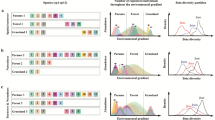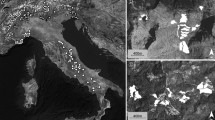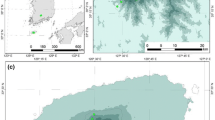Abstract
The empidid fauna of four small adjacent biotopes bordering a pond was investigated for 2 consecutive years in Brittany (France). Adult activity was studied using yellow water traps, whereas suitable larval habitats were determined using emergence traps. While 24 species emerged from the soils, 45 flew above the four sites. The number of species emerging from each site was nearly identical. However, the highest number of individuals emerged from the heathland and numbers rapidly declined towards the pond banks. On the contrary, the greatest aerial activity occurred in the woodlot and near the pond banks. Fourteen times less flying activity was found above the dry heathland. The latter appeared to be a site of larval growth but mating and feeding of the adults took place in the woodlot. Reproduction sites and space used by the adults differed among the dominant species. The species assemblage could not be fully explained within the spatial limits of the four sites. Considering the species'behaviour, it is suggested that immigration of species and individuals from other sites should explain these differences. The study, which is supported by four other research works, emphasizes the role of key resource played by ecotonal zones between aquatic and terrestrial ecosystems in the persistence of species over a larger set of habitats. Considering the complementarity of habitats is essential to explain diversity patterns in species which need different space units to complete their life-cycle.
Similar content being viewed by others
References
Bährmann, R. (1984) Oeko-faunistische Untersuchungen an Tanzfliegen (Empididae, Diptera) im Leutratal bei Jena (Thüringen). Wiss. Z. Friedrich-Schiller-Univ. Jena, Naturwiss. R. 5, 33, 225–49.
Bährmann, R. (1994) Beiträge zur Faunistik un Okologie des Naturschutzgebeites 'Apfelstädter Ried', Kreis Erfurt-Land (Thüringen) Teil VII. Empididae, Hybotidae, Microphoridae (Insecta: Diptera: Empidoidea). Faun. Abh. Staatl. Mus. Tierk. Dresden 19, 193–205.
Bailliot, S. and Tréhen P. (1974) Variations de l'attractivité des pièges colorés de Moericke enfonction de la localisation spatio-temporelle de l'émergence, des comportements sexuels et des phases de dispersion de quelques espèces de Diptè res. Ann. Zool. Ecol. Anim. 6, 574–84.
Benzecri, J.P. (1973) L'analyse des données. La taxinomie.Vol.1. Paris: Dunod.
Blanchart E., Frenot Y. and Tréhen P. (1987) Signification biologique du potentiel hydrique dans la distribution des Diptères à larves hydrophiles. Pedobiologia 30, 333–44.
Dale, M.R.T. (1988) The spacing and intermingling of species boundaries on an environmental gradient. Oikos 53, 351–56.
Delettre, Y.R (1986) La colonisation de biotopes multiples: une alternative à la résistance in situ aux conditions mésologiques défavorables. Cas de Limnophyes minimus (Mg.), Diptère Chironomide à larves édaphiques des landes armoricaines. Rev. Ecol. Biol. Sol. 16, 355–72.
Delettre, Y.R. (1992) Terrestrial Chironomidae: contribution of local emergence to global aerial flow in a heterogeneous environment. Neth. J. Aquatic. Ecol. 26, 269–71.
Delettre, Y.R., Tréhen, P. and Grootaert, P. (1992) Space heterogeneity, space use and short-range dispersal in Diptera-a case study. Landscape Ecol. 6, 175–81.
Den Boer, P.J. (1982) On the stability of animal populations, or how to survive in a heterogeneous world? In Environmental Adaptation and Evolution (D. Mossakowski and G. Roth, eds) pp. 211–232. Jena, Stuttgart: Gustav Fisher.
Den Boer, P.J. (1990) The survival value of dispersal in terrestrial arthropods. Biol. Conserv. 54, 175–92.
Duviard, D. and Blanchet, F. (1983) Studies by trapping of the Empididae (Diptera) of crushed household refuse spread on an Ulex heathland of Central Brittany. Acta Oecol., Oecol. Applic. 4, 109–22.
Grootaert, P. (1994) Seksuelle selectie en speciatie bij Diptera. Verhandeling ingediend tot het bekomen van het diploma van Geagregeerde van het Hoger Onderwijs. Faculteit Wetenschappen Vakgroep Biologie Universiteit Gent, 241 pp.
Hövemeyer, K. (1987) Die Tanzfliegen (Diptera, Empididae) eines Kalkbuschenwaldes: Koexistenz der Arten. Mitt. Dtsch. Ges. Allg. Angew. Ent. 5, 49–52.
Krizelj, S. (1971) Recherches sur l'écosystème forêt. Série C: La chenaie à Galeobdolon et à Oxalis de Mesnil-Eglise (Ferage). Contrib. No. 24. Méthodes d'étude des entomocoenoses forestières. Bull. Inst. R. Sci. Nat. Belg. 47, 1–10.
Lebreton, J.D., Sabatier, R., Banco, G. and Bacou, A.M. (1991) Principal component and correspondence analysis, with respect to instrumental variables; an overview of their role in studies of structure, activity and species environment relationships. In Applied Multivariate Analysis in SAR and Environmental Studies (J. Devillers and W. Karcher, eds) pp. 85–114. Brussels: ECSC, EEC, EAEC.
Meyer, H. and Heydemann, B. (1990) Faunistische-ökologische Untersuchungen an Dolichopodiden und Empididen (Diptera-Dolichopodidae und Empididae, Hybotidae) in Küsten-und Binnenlandbiotopen Schleswig-Holstein. Faun. ökol. Mitt. 6, 147–72.
Morvan, N. (1996) Structure et biodiversité de paysages de bocage: le cas des Empidides (Diptera: Empididae). Thèse de Doctorat, Université de Rennes I, 164 pp.
Morvan, N., Delettre, Y.R., Tréhen, P. and Burel, F. (1994) The distribution of Empididae (Diptera) in hedgerow network landscapes. Br. Crop Protect. Council Monogr. 58, 123–7.
Naeem, S. and Colwell, R.K. (1991) Ecological consequences of heterogeneity of consumable resources. Ecol. Heterogen. 86, 224–55.
Pollet, M. (1992) Impact of environmental variables on the occurrence of dolichopodid flies in marshland habitats in Belgium (Diptera: Dolichopodidae). J. Nat. Hist. 26, 621–36.
Pollet, M. and Grootaert, P. (1994) Optimising the water trap technique to collect Empidoidea (Diptera). Studia dipterologica. 1, 33–48.
Pollet, M. and Grootaert, P. (1996) An estimation of the natural value of dune habitats using Empidoidea (Diptera). Biodiversity Conserv. 5, 859–80.
Roff, D. (1977) Dispersal in Dipterans: its costs and consequences. J. Animal Ecol. 46, 443–56.
Rohlf, F.J. (1990) NTSYS-pc, Numerical Taxonomy and Multivariate Analysis System. New York: Exeter Software.
Stark, A. and Wetzel, Th. (1987) Fliegen der Gattung Platypalpus (Diptera, Empididae)-bischer wenig beachtete Pradatoren im Getreidebestand. J. Appl. Entomol. 103, 1–14.
Taylor, A.D. (1990) Metapopulation, dispersal and predator-prey dynamics: an overview. Ecology 71, 429–33.
Ter Braak, C.J.F. (1987) CANOCO-a FORTRAN program for Canonical Community Ordination by [ partial ] [Detrended ] [Canonical ] Correspondence Analysis, Principal Components Analysis and redundancy Analysis. Wageningen: ITI-TNO.
Tréhen, P. (1968) Contribution à l'étude du comportement naturel et à l'écologie de Megacyttarus crassirostris Fallén 1816. Vie Milieu, Ser. C 19, 469–84.
Tréhen, P. (1969) Contribution à l'écologie des Diptè res Empidides. II. Description et analyse écologique des différents comportements de vol et de pariade chez plusieurs espèces du genre Hilara Meigen. Rev. Com. Animal 3, 1–24.
Tréhen, P. (1971) Recherches sur les Empidides à larves édaphiques. Thè se Docrorat d'Etat, Université de Rennes I, 280 pp.
Tréhen, P. (1972) Ecologie des Diptères Empidides à larves é daphiques. Bull. Soc. Ecol. 3, 173–191.
Tréhen, P., Bailliot, S. and Delettre, Y.R. (1977) Caractéristiques spatio-temporelles des é mergences de Diptères du sol. Ecol. Bull. (Stockholm) 25, 521–3.
Turner, M.G. (1989) Landscape Ecology: the effect of pattern on process. Annu. Rev. Ecol. Syst. 20, 171–97.
Author information
Authors and Affiliations
Rights and permissions
About this article
Cite this article
Delettre, Y.R., Morvan, N., Tre´HEN, P. et al. Local biodiversity and multi-habitat use in empidoid flies (Insecta: Diptera, Empidoidea). Biodiversity and Conservation 7, 9–25 (1998). https://doi.org/10.1023/A:1008851511301
Published:
Issue Date:
DOI: https://doi.org/10.1023/A:1008851511301




